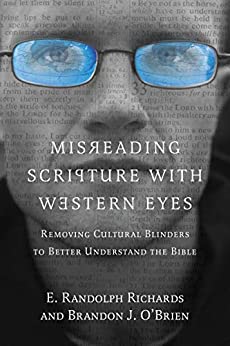Book Review of "Misreading Scripture with Western Eуes: Removing Cultural Blinders to Better Understand the Bible"

Summary
In this book, Randy Richards and Brandon O'Brien (2012), biblical scholars focus on shedding light on how the Bible’s cultural dynamics are misunderstood especially by Western readers. In particular, the scholars are interested in addressing the issue of cultural-self-awareness for the readers and audience of the Bible. In essence, cultural self-awareness proves to be a common problem either in regard to interpreting the work done by others or ancient texts.
In this endeavor, they take note of nine core areas where modern Christians, Bible readers and the audience from the Western sphere have a significant divergent views pertaining to what might be wrong in the Bible text. The work also entails a relation of the author’s own cross-cultural experience in a global mission in showcasing how social mores, time, cultural variations in language and better self-awareness could enabled readers and the audience in seeing the Bible in a new and fresh way. For instance, Richard had worked a missionary in Indonesia for many years, where mores and cultural norms are significantly divergent from those in the West.
The core aim of the scholars in drafting this book is show Christians the essence of getting beyond their cultural assumptions in this increasingly globalized and interconnected world. Furthermore, the authors recommend Christians to consider reading the scripture in the context of a global body of Christ. The key thesis of Richards and O'Brien’s text is that Western readers are sightless when it comes to cultural nuances that are taken for granted by those living in other cultures. Consequently, Westerners may not always have a true reflective of a particular bible passage, whether that text is didactic or narrative. The green lights provided by the readers are intended to enable readers to comprehend their cultural variations as a lead up to reading and approaching a bible passage.
Analysis
The front cover of Misreading “Scripture with Western Eyes” is in itself eye catching and appealing. There is a picture of a male, white face, whose eyes are covered by tinted glass gazing outwards from behind the front page of the book. Looking at the title, the author’s key theme is very much clear on the title; Western Christians read and interpret the bible through Western eyes. The revelation is not particularly new, but rather common phenomena pertaining to arguments on biblical interpretations in academic and popular circles as further admitted by O'Brien and Richards. Indeed, most people across different cultural settings have a tendency of applying their “unique” cultural habits to the bible , consisting of profoundly ingrained patterns of how the world is interpreted in warping and shaping their individual interpretation and comprehension of the scripture.
In this book, it is clear that O'Brien and Randolph are writing with clarity and grace. Despite the duo being evangelical, they have tried as much as possible to avoid political and moral agendas as well as sentiments that may be anti-western in nature. This means that the book is neither a support nor an attack of Western values and culture. They even go ahead to recommend that a complimentary sequel to their book should be written by someone from Eastern spheres. They have supported their arguments using extensive range of modern day samples, and biblical resources, subsequently making the book a confessional bible study text to heighten biblical interpretation.
The author’s key intent is to assist Western readers in identifying in a more effective way, how the eyeglasses through which individuals view and interpret all things inherent in the environment which is the Western culture influences how they read, comprehend and interpret biblical texts they read or read to them. In order to read the scripture well, individuals need to relate their self-identity and their culture well. Richards and O'Brien have extensively utilized a metaphor of an iceberg in illustrating their point. When an iceberg is pictured looming in a distance, very little of it can be seen. Although the iceberg’s tip may be seen through the water and offer an indication of its presence, the immensity or the larger part of the iceberg remains in the depth. The iceberg which is a controlling metaphor of this book has three parts. Part one relates to the issues or matters that are above the surface of the water and which can be easily seen. Part two relates to issues that are below the water surface and which may not be seen easily. Part three which is the last part deals with issues which are deeply below the water surface and are difficult to view. In the same way, individual’s perceptions about their culture’s pressures and patterns, that is what they consciously believe, say, eat or wear may be considered as a tip of the iceberg. On the other hand, majority of individual’s cultural patterns are immersed below the surface, beyond their conscious awareness and out of plan sight.
In this regard, the authors presents a detailed description of how many cultures harbor things that may not be said and how things that remained undercover some two centuries ago are missed when read in today’s perspective. This is also the same way concerning the things that people add to scriptures owing to the attempt of adding things that go unsaid in their culture. In light of this, it becomes challenging to know how people’s culture affects what they read into the scriptural events, or fail to comprehend them at all. There are many people that are overlooked, overly considered, or those incorrectly applied by individuals while interpreting the scripture because of not getting the right intent of the original authors.
The author’s thesis is that cultural values, particularly those that go unsaid have a significant effect regarding the manner in which individuals read, or misread the bible text. In this endeavor, the author raises the question “what do assumptions, and cultural contexts cause individuals to overlooking when they interpret scriptures?” The authors are stirred by the nuance that some of the habits brought to the bible harbored by Western readers (particularly those from Western Europe, Canada and the United States), blind them regarding correct interpretation which the original readers and audience from other cultures perceive as being natural. Therefore, O’Brien and Randolph intent to provide a positive correction by recommending that the pattern in which Western readers and audience misread or read the bible text is discernible.
As observed by the authors, those interpreting the bible may not even notice that they are applying their cultural assumptions into their biblical text. However, the authors emphasize that what goes without being said pertaining to specific mores may lead to misreading and thus incorrect interpretation of the Bible. On the other hand, if biblical interpreters strive to unmask their more, then they will be in a better position in reading and understanding the bible the way it should. Concerning ethnicity and racism, the authors also observes that racisms still plays a significant role in influencing the way people read and interpret scriptures. For instance, there are many sections of American citizens, scholars and even pastors who believe that Moses’ Cushite wife was a slave due to the assumption that she was from an African decent when she was in essence cultural elite. Although there is a high likelihood of Moses marrying up instead of down, Western readers are in most cases blinded to this possibility owing to their racial prejudice. The authors also argue that language was and is the most insidious and obvious issues pertaining to cross-cultural biblical misinterpretation or interpretation. Therefore, they successfully attempt to unravel some of the inherent habits of the Western language which has influenced the way people interpret and understand scripture.
Conclusion
In essence, the text Misreading Scripture with Western Eyes has much value to its intended audience. The books main theme is not only admirable, but also necessary. There is no doubt that the book can be effectively be used to convince readers that for an efficient grasping of what the scripture means to our life as Christians, then it is necessary to look out the scripture’s intent to its original audience. This understanding will make this book to be a great gain for the authors and the Western readers. What is more, the book also presents a significant insight that translates to a valuable contribution to Christianity and an understanding of scripture. For instances, discussions pertaining to salvation and sin as an aspect of being Christ or in Adam is a common preaching theme for many American preachers. How O’Brien and Richard treat the element of individualism also adds more value to the culture of both the new and Old Testament categories. Furthermore, the chapter on ethnicity and race presents a vital case in point whereas various factions may have arisen in Corinth, we can see how the different factions were forced to seek support from each other in various perspectives. For instance, Alexandrian Jews were forced to look unto Appollos, while Aramaic speakers were seeking for assistance from Cephas.
Despite the fact a lot of the concepts explained in the book may be regarded as basic, they work well in reminding Christians and leaders at large that in order to grasp the true meaning of a scripture, its paramount to establish an awareness regarding the relationship between biblical interpretation and culture.








